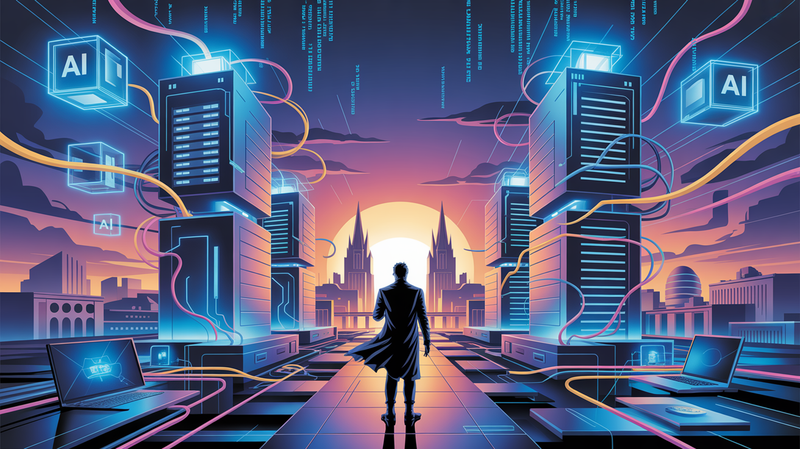Harnessing Artificial Intelligence for an Equitable Future: A 2024 Perspective
In the year 2024, artificial intelligence (AI) has transitioned from the fringes of imagination to a central force in our everyday existence. This remarkable evolution of technology stands at the forefront of shaping our future, wielding the power to redefine the boundaries of possibility. As AI integrates deeper into the

In the year 2024, artificial intelligence (AI) has transitioned from the fringes of imagination to a central force in our everyday existence. This remarkable evolution of technology stands at the forefront of shaping our future, wielding the power to redefine the boundaries of possibility. As AI integrates deeper into the fabric of society, it presents us with a critical juncture: the opportunity to steer its course towards a future that not only transcends the limitations and inequities of previous technological revolutions but also envisions a world where fairness, inclusivity, and human welfare are at the core of technological progress.
In this transformative era, AI emerges not just as a tool or a silent background actor but as a catalyst for profound change, challenging us to reflect on how we can harness its vast potential responsibly. The decisions we make and the paths we choose now will determine whether AI becomes a force that widens societal divides or one that bridges them, a technology that entrenches existing disparities or one that dismantles barriers and opens doors to new opportunities for all.
As we stand on the brink of this new horizon, the question that confronts us is not merely about the capabilities of AI but about our vision for the future it will help shape. Will we guide AI to foster a world that values human dignity, promotes social justice, and cultivates an environment where every individual has the chance to flourish? This is the challenge and the promise of AI in 2024—a pivotal moment to embrace the potential of this technological titan in creating a tapestry rich with the hues of equity and inclusivity, woven into the very fabric of our shared future.
AI as an Opportunity: Crafting a Fairer Future
The dawn of artificial intelligence (AI) technology heralds a transformative era in human history, one brimming with the potential to reshape societal structures, economies, and personal lives. Unlike any technological advancement before it, AI presents a unique opportunity to correct the course of past digital revolutions—ones that, while revolutionary, often widened the gap between the haves and have-nots, leaving behind a digital divide that persists to this day.
Learning from the Digital Revolution
The initial wave of digital technology promised to democratize access to information, enhance connectivity, and foster economic growth. And to a great extent, it succeeded. However, this success was not evenly distributed. According to the United Nations, as of 2021, an estimated 37% of the world's population has never used the internet. This digital divide is not merely about connectivity; it reflects disparities in education, economic opportunities, and access to technology.
AI offers a chance to learn from these oversights. By embedding principles of fairness and inclusivity from the outset, we can guide AI development to benefit all segments of society, not just a privileged few. This entails a commitment to making AI technologies accessible, understandable, and usable for everyone, ensuring that AI tools are developed with a diverse range of needs and contexts in mind.
Focusing on Equity Over Corporate Profit
The drive towards AI development is often fueled by the pursuit of innovation and economic gain. While these are important goals, prioritizing them over equity and ethical considerations can lead to unintended consequences. For AI to truly serve as a force for good, it must be guided by a commitment to social justice, ensuring that its benefits are accessible to all members of society, particularly those who have been historically marginalized or disadvantaged.
This commitment to equity requires a multifaceted approach:
- Inclusive Design: AI systems must be designed with diverse inputs and perspectives, ensuring they serve a broad spectrum of human needs and are free from biases that can perpetuate inequality.
- Ethical AI Development: Developers and corporations must prioritize ethical considerations in AI development, focusing on long-term societal impacts over short-term gains.
- Public Engagement: Engaging the public in conversations about AI's role in society can foster a more informed and inclusive approach to its development.
The Path Forward
As we continue to harness AI's potential, the focus must remain steadfast on creating a future where technology acts as a lever for social equity. This involves not only leveraging AI to address specific challenges such as healthcare, education, and economic inequality but also ensuring that the process of AI development itself is inclusive, ethical, and aligned with the broader goals of human flourishing.
The task ahead is complex and requires the collaboration of policymakers, technologists, civil society, and the global community. Yet, by embracing the lessons of the digital revolution and prioritizing equity in the advancement of AI, we stand on the cusp of an era where technology truly serves humanity, offering a beacon of hope for a fairer future for all.
Regulation and Inclusion: The Pillars of Equitable AI Development
In the quest to harness the full potential of artificial intelligence (AI) for the betterment of society, regulation and inclusion emerge as critical pillars. These elements are not just about controlling or limiting AI's capabilities; they are about steering its development in a direction that aligns with democratic values, human rights, and social justice. The complexity of AI, with its far-reaching implications across various sectors, necessitates a nuanced approach to regulation—one that fosters innovation while ensuring the technology benefits all members of society.
The Importance of AI Regulation
AI's rapid advancement presents unique challenges that existing regulatory frameworks are often ill-equipped to address. From privacy concerns and ethical dilemmas to the potential for job displacement and social inequality, the stakes are high. The need for regulation is twofold: to mitigate the risks associated with AI technologies and to create an environment where the benefits of AI can be universally accessed and enjoyed.
The European Union’s AI Act and President Biden’s executive order on AI policy are prime examples of proactive steps taken by governments to shape the trajectory of AI development. These regulatory efforts share a common goal: to establish clear guidelines that balance innovation with ethical considerations, data protection, and fairness.
Democratizing AI Through Inclusive Regulation
Effective AI regulation must also be inclusive, ensuring that the voices of all stakeholders, especially those from marginalized and underrepresented communities, are heard. Inclusion in AI regulation involves:
- Public Consultation: Engaging with the public to gather diverse perspectives on how AI should be developed and used.
- Global Collaboration: Working with international partners to develop standards and regulations that reflect a broad range of cultural and ethical norms.
- Accessibility and Transparency: Making AI technologies and their governance mechanisms accessible and understandable to everyone, empowering individuals to make informed decisions about their interaction with AI.
Examples of Inclusive AI Initiatives
Initiatives like the EU's AI Act and UNESCO’s AI ethics recommendations illustrate the global effort to harmonize AI development with ethical standards and human rights principles. These initiatives aim not only to regulate but also to guide AI development in a way that respects individual autonomy, privacy, and the need for equitable access to technology.
The Role of AI in Promoting Social Inclusion
Beyond regulation, AI itself can be a powerful tool for fostering social inclusion. By designing AI systems that address the needs of diverse populations, including people with disabilities, ethnic minorities, and other marginalized groups, technology can become a force for social equity. This includes the development of AI applications in education, healthcare, and economic opportunity that are tailored to the needs of these communities.
As we continue to explore the vast potential of AI, the principles of regulation and inclusion stand as beacons, guiding our path forward. By embedding these principles into the fabric of AI development, we can ensure that this powerful technology serves as a catalyst for positive change, promoting a future where innovation and equity go hand in hand.
AI Governance: Human-Centric Approaches for a Just Future
As artificial intelligence (AI) technologies become increasingly integral to our daily lives, the question of how to govern these powerful tools takes on paramount importance. AI governance is about more than just managing the technical aspects of AI development; it's about ensuring that AI systems are developed and deployed in ways that are ethical, equitable, and aligned with human values and societal goals. This necessitates a shift toward human-centric approaches that prioritize the well-being of individuals and communities.
The Need for New Governance Models
Traditional models of technology governance, which often focus on efficiency and innovation, are insufficient for addressing the unique challenges posed by AI. The autonomous and sometimes opaque nature of AI systems, combined with their potential to influence a wide range of human activities, calls for governance models that are responsive to ethical considerations, capable of managing complex risks, and committed to promoting social justice.
Principles of Human-Centric AI Governance
Human-centric AI governance is built on several key principles:
- Transparency and Accountability: AI systems should be transparent in their operations, and there should be clear accountability mechanisms for the outcomes they produce. This includes the ability to trace decisions made by AI systems back to their developers or operators.
- Ethical Design and Deployment: AI should be designed and deployed in accordance with ethical guidelines that prioritize human rights, privacy, and dignity. This involves implementing ethical review processes throughout the AI development lifecycle.
- Participatory Governance: Stakeholders, including those from marginalized and underrepresented communities, should have a say in how AI systems are governed. This can include public consultations, stakeholder advisory boards, and other mechanisms for incorporating diverse perspectives.
- Adaptive Regulation: Given the rapid pace of AI innovation, governance frameworks must be flexible and adaptive, capable of evolving in response to new developments and challenges.
Case Studies in AI Governance
Several initiatives illustrate the ongoing efforts to implement human-centric AI governance:
- The European Commission's High-Level Expert Group on AI developed ethics guidelines for trustworthy AI, emphasizing the need for AI systems to be lawful, ethical, and robust.
- The Global Partnership on AI (GPAI), an international initiative, aims to support responsible and human-centric development and use of AI, fostering international collaboration to guide AI governance.
- AI Now Institute focuses on researching the social implications of AI technologies and advocating for regulatory approaches that prioritize social justice and equity.
The Role of AI in Enhancing Governance
AI itself can play a role in enhancing governance processes. By leveraging AI for public consultation, policy analysis, and decision-making support, governments and organizations can make governance more inclusive, responsive, and effective. AI can help analyze vast amounts of data to identify public concerns, predict the impacts of policy choices, and facilitate more informed decision-making.
The governance of AI is a critical factor in determining whether this technology will be a force for good or a source of new challenges and inequalities. By adopting human-centric governance models that prioritize ethical considerations, transparency, and inclusivity, we can ensure that AI serves the interests of humanity and contributes to a just and equitable future.
Technological Equality: Bridging the Digital Divide with AI
The aspiration for technological equality in the age of artificial intelligence (AI) revolves around a fundamental principle: the benefits of AI should not be a luxury reserved for a privileged few but a universally accessible resource that empowers all individuals across the globe. Achieving this goal necessitates addressing the digital divide—the gap between those who have access to modern information and communication technology, and those who do not. Bridging this divide is crucial for ensuring that AI acts as a lever for social equity, rather than exacerbating existing inequalities.
Understanding the Digital Divide
The digital divide manifests in various forms: disparities in access to the internet and digital devices, differences in digital literacy, and inequalities in the capacity to use technology effectively. These disparities are not just between countries but also within them, affecting rural communities, elderly populations, and economically disadvantaged groups the most.
AI's Role in Promoting Access and Inclusion
AI has the potential to significantly narrow the digital divide by enhancing access to information, improving educational outcomes, and providing new opportunities for economic empowerment. Here are some ways AI can contribute to technological equality:
- Educational AI Tools: AI can personalize learning experiences, making education more accessible and effective for students regardless of their background. By adapting to each learner's pace and style, AI-powered educational platforms can help overcome barriers faced by those in under-resourced communities.
- Healthcare Accessibility: AI applications in healthcare, such as diagnostic tools and telemedicine services, can extend quality medical care to remote and underserved populations. By reducing the need for physical infrastructure and expert personnel in every location, AI can help bridge the healthcare divide.
- Economic Empowerment: AI can enable economic inclusion by providing individuals with access to financial services, such as credit and insurance, through mobile platforms. Additionally, AI-driven platforms can connect small farmers, artisans, and entrepreneurs with broader markets, enhancing their income and livelihood opportunities.
- Enhancing Connectivity: AI can optimize the deployment of infrastructure, like internet connectivity, to underserved areas. By analyzing data on geography, population density, and existing infrastructure, AI tools can help plan more efficient and cost-effective solutions to expand digital access.
Challenges and Considerations
While AI offers promising solutions for bridging the digital divide, its deployment must be handled with care to avoid reinforcing existing inequalities. Key considerations include:
- Ensuring AI Accessibility: AI tools and services should be designed to be accessible to those with varying levels of digital literacy and in languages understood by target communities.
- Addressing Bias: AI systems must be developed to mitigate biases that could perpetuate discrimination or unequal treatment of certain groups.
- Sustainable and Inclusive Deployment: The expansion of AI solutions should be accompanied by efforts to enhance digital literacy and ensure the sustainability of technological infrastructure in underserved areas.
Achieving technological equality in the era of AI requires a concerted effort from governments, industry, civil society, and communities. By leveraging AI as a tool for empowerment and inclusion, we can work towards a future where everyone has the opportunity to benefit from the advancements of the digital age. Bridging the digital divide is not only a matter of access but also of ensuring that AI development is guided by the principles of equity, inclusivity, and social good.
Innovation and Diversity: Reflecting the Spectrum of Humanity in AI
In the journey toward an equitable future shaped by artificial intelligence (AI), innovation and diversity play pivotal roles. The essence of innovation in AI is not merely about technological breakthroughs but about ensuring these advancements are inclusive and reflective of the broad spectrum of human experiences. Diversity in AI—encompassing gender, race, ethnicity, socioeconomic background, and beyond—is critical for crafting AI systems that are fair, unbiased, and beneficial for all segments of society.
The Value of Diverse Perspectives in AI Development
Diverse perspectives in AI development are invaluable for several reasons:
- Mitigating Bias: AI systems learn from vast datasets, and if these datasets are biased or unrepresentative, the AI's decisions and predictions will be too. Involving a diverse group of creators and decision-makers in AI development helps identify and correct biases that may not be apparent to a more homogenous group.
- Enhancing Creativity and Innovation: Diversity fuels creativity by bringing together a wide range of ideas, problem-solving approaches, and insights. This diversity of thought can lead to more innovative solutions and breakthroughs in AI technology.
- Addressing a Broader Range of Needs: AI developed by diverse teams is more likely to address the needs and challenges of a wider array of users, making technology more accessible and useful to people from different backgrounds and with different abilities.
Promoting Diversity in the AI Field
Promoting diversity within the AI field requires concerted efforts across education, industry, and policy:
- Education and Outreach: Initiatives to encourage underrepresented groups to pursue STEM (Science, Technology, Engineering, and Mathematics) education and careers are crucial. This includes scholarships, mentorship programs, and community outreach efforts designed to inspire interest in AI and technology from a young age.
- Inclusive Hiring and Career Advancement: Organizations must commit to inclusive hiring practices, ensuring that recruitment, retention, and promotion policies support diversity. This also involves creating a workplace culture that values inclusivity and provides all employees with opportunities to grow and lead.
- Supporting Diverse Innovators: Funding and resources should be made available to startups and projects led by underrepresented groups in the AI field. Incubators, accelerators, and grant programs specifically targeting diversity can help level the playing field for diverse innovators.
Case Studies of Diversity Driving Innovation in AI
Several organizations and initiatives exemplify the commitment to diversity and innovation in AI:
- AI4ALL: This nonprofit organization aims to increase diversity and inclusion in AI education, research, development, and policy. AI4ALL's programs educate young people from underrepresented groups about AI, empowering them to become future leaders in the field.
- Algorithmic Justice League: Founded by Joy Buolamwini, this organization focuses on highlighting and mitigating bias in AI. Their research and advocacy work have been instrumental in raising awareness about the importance of inclusive and ethical AI development practices.
- Black in AI: A community of Black researchers and practitioners in AI, Black in AI fosters collaborations, mentorships, and support for Black individuals in the field. The organization also advocates for increased visibility and opportunities for Black people in AI.
The path toward a future where AI benefits everyone equally is paved with the principles of innovation and diversity. By ensuring that AI development reflects the full spectrum of human experiences and perspectives, we can create technologies that are not only more equitable and just but also more innovative and effective. As the AI field continues to evolve, the commitment to diversity and inclusion will remain a cornerstone of building a technology landscape that truly serves humanity.
The Role of Civil Society in Shaping Equitable AI Development
Civil society plays a critical and multifaceted role in ensuring artificial intelligence (AI) serves the public good and contributes to a more equitable society. Comprising non-governmental organizations (NGOs), nonprofits, academia, community groups, and activists, civil society acts as a bridge between the general public and the realms of government and industry, advocating for policies, practices, and innovations that prioritize social welfare, inclusivity, and human rights in the development and deployment of AI technologies.
Advocacy and Accountability
One of the key roles of civil society in the context of AI is advocating for ethical standards, transparency, and accountability. By raising awareness of the potential risks and ethical dilemmas posed by AI, civil society organizations (CSOs) can press for regulations and frameworks that ensure AI systems are developed and used responsibly. This includes campaigning for privacy protections, bias mitigation, and the equitable distribution of AI benefits.
Inclusion and Representation
Civil society also champions the cause of inclusion and representation in AI. Through initiatives aimed at broadening participation in AI development, CSOs work to ensure that diverse voices are heard and considered in shaping AI policies and technologies. This effort is crucial for addressing and preventing algorithmic biases that can reinforce societal inequities. Programs that encourage underrepresented groups to engage with AI, whether through education, career opportunities, or community-led projects, help democratize AI and make it more reflective of society's diversity.
Education and Awareness
Educating the public about AI and its implications is another vital function of civil society. By providing accessible information and resources, CSOs help demystify AI technologies and empower individuals to make informed decisions about their interaction with AI systems. Education initiatives can also inspire informed public discourse on the ethical, social, and political dimensions of AI, fostering a more literate society that can actively participate in shaping the future of technology.
Collaboration and Innovation
Civil society often serves as a catalyst for innovation in AI by fostering collaborations between researchers, technologists, policymakers, and communities. These partnerships can lead to the development of AI solutions that address social challenges, such as improving healthcare access, enhancing educational outcomes, and combating climate change. Moreover, civil society can support grassroots innovations and social enterprises that leverage AI for community development and social justice.
Case Studies: Civil Society's Impact on AI
- AI for Good: An initiative that brings together AI experts, NGOs, and other stakeholders to develop AI solutions that contribute to the United Nations Sustainable Development Goals (SDGs).
- Data & Society: A research institute focused on social and cultural issues arising from data-centric technological development, including AI, offering insights and analyses that inform public debate and policy.
- Access Now's AI Policy Work: This international organization advocates for the rights of users at risk around the world, including working on policies that govern AI and digital rights to ensure technologies are used in ways that respect human rights.
The role of civil society in shaping equitable AI development is indispensable. Through advocacy, inclusion efforts, education, and collaborative innovation, civil society ensures that AI technologies are developed and deployed in ways that serve humanity's best interests, safeguarding against the exacerbation of inequalities and promoting a future where technology amplifies social good.
Upholding Societal Values in AI Development: A Call for Human-Centric Technology
As artificial intelligence (AI) becomes increasingly woven into the fabric of society, the imperative to uphold and reflect societal values in AI development grows more urgent. This challenge is not merely technical but deeply philosophical, demanding that we consider what kind of future we wish to create with AI and how the technology can serve the broad spectrum of human values and ethics. Upholding societal values in AI necessitates a deliberate, multidisciplinary approach that prioritizes human dignity, rights, and well-being in the face of rapid technological advancement.
Defining Societal Values in the Context of AI
Societal values encompass a range of principles and beliefs that guide behavior and decision-making within a community or society. These values include fairness, justice, equality, freedom, privacy, and respect for human rights. In the context of AI, upholding these values means developing and deploying technologies that enhance rather than undermine these principles, ensuring that AI systems contribute to the common good.
Challenges in Reflecting Societal Values in AI
One of the significant challenges in embedding societal values into AI is the diversity of these values across different cultures and communities. What is considered ethical or fair in one context may not be universally agreed upon, making the development of universally ethical AI systems a complex task. Moreover, the inherent biases in data and the risk of AI systems amplifying existing societal inequalities further complicate the effort to uphold values in AI.
Strategies for Integrating Societal Values into AI
To ensure that AI systems uphold and reflect societal values, several strategies can be employed:
- Ethical AI Frameworks: Developing comprehensive ethical frameworks that guide AI research and development is crucial. These frameworks should be informed by a broad range of stakeholders, including ethicists, sociologists, technologists, and representatives from affected communities.
- Participatory Design: Involving diverse groups of people in the design and development process of AI systems can help ensure that a wide range of values and perspectives are considered. This participatory approach can lead to more inclusive and equitable AI solutions.
- Transparency and Accountability: Making AI systems transparent in their decision-making processes and ensuring that there are mechanisms for holding developers and operators accountable are essential for upholding societal values. This includes the ability to audit AI systems and challenge decisions that may be unethical or discriminatory.
- Continuous Monitoring and Evaluation: AI systems should be continuously monitored and evaluated to ensure they align with societal values over time. This involves assessing the impacts of AI on various segments of society and making necessary adjustments to address any negative consequences.
The Role of Dialogue in Shaping Value-Centric AI
Engaging in ongoing dialogue about the role of AI in society and the values it should serve is vital. This dialogue should not be confined to experts in technology and ethics but should include the wider public, ensuring that AI development is driven by a democratic and inclusive process. Such conversations can help society collectively decide on the priorities for AI development and the ethical boundaries it should respect.
Upholding societal values in the development and deployment of AI is essential for ensuring that technology serves humanity's best interests. By embedding these values into AI systems, we can harness the potential of AI to enhance human welfare, promote social justice, and enrich the quality of life. The task ahead is complex and requires the collective effort of all stakeholders involved in AI development. Through collaboration, dialogue, and a commitment to ethical principles, we can guide AI towards a future that respects and amplifies the values we hold dear.
A Call to Action: Shaping the Future of AI for the Common Good
As we stand at the cusp of a new era shaped by artificial intelligence (AI), the collective responsibility to steer this powerful technology towards a future that benefits all of humanity has never been more critical. The discussions around AI’s potential, its governance, the importance of diversity and inclusivity, the role of civil society, and the imperative to uphold societal values, all converge to a pivotal call to action for stakeholders at every level of society.
For Policymakers and Regulators:
- Develop and Enforce Ethical AI Frameworks: Create comprehensive policies and regulations that ensure AI development is guided by ethical principles, emphasizing transparency, accountability, and fairness.
- Promote International Collaboration: Work with international bodies to harmonize AI standards and regulations, facilitating global cooperation in addressing the challenges posed by AI.
For AI Developers and Technologists:
- Prioritize Ethical AI Development: Embed ethical considerations into the AI development process, from the initial design phase through deployment and beyond.
- Engage in Responsible Innovation: Innovate responsibly by considering the societal impacts of AI technologies and striving to mitigate risks associated with bias, privacy, and security.
For Businesses and Industry Leaders:
- Adopt AI Ethics Guidelines: Implement guidelines for ethical AI use within organizations, ensuring that business practices align with societal values and contribute to the common good.
- Support Equitable Access to AI: Invest in initiatives that democratize access to AI technologies and skills, particularly for underrepresented communities.
For Academia and Research Institutions:
- Foster Interdisciplinary Research: Encourage research that bridges technology, ethics, sociology, and other disciplines to explore the multifaceted implications of AI.
- Educate the Next Generation: Integrate AI ethics, governance, and societal impact studies into curricula, preparing students to navigate the complex landscape of AI.
For Civil Society and Community Organizations:
- Advocate for Inclusive AI: Champion the cause of inclusivity and equity in AI, ensuring that the voices of marginalized and underrepresented groups are heard.
- Raise Awareness and Educate: Engage in public education campaigns to raise awareness about AI’s potential risks and benefits, empowering individuals to participate actively in shaping AI’s role in society.
For Every Individual:
- Stay Informed: Seek to understand AI and its implications for society, remaining informed about how AI technologies are being developed and used.
- Engage in Dialogue: Participate in discussions about the ethical use of AI, voicing your perspectives and concerns to influence how AI shapes our future.
Conclusion: A Collective Journey Towards Ethical AI
The journey towards realizing the full potential of AI in a way that benefits humanity and upholds our shared values is a collective one. It requires the engagement, vigilance, and collaboration of all stakeholders. By taking concrete steps to address the ethical, social, and technical challenges posed by AI, we can harness this powerful technology to create a future that reflects our highest aspirations for equity, justice, and the common good. The time to act is now—let us come together to shape the trajectory of AI, ensuring it serves as a force for positive transformation in the world.




